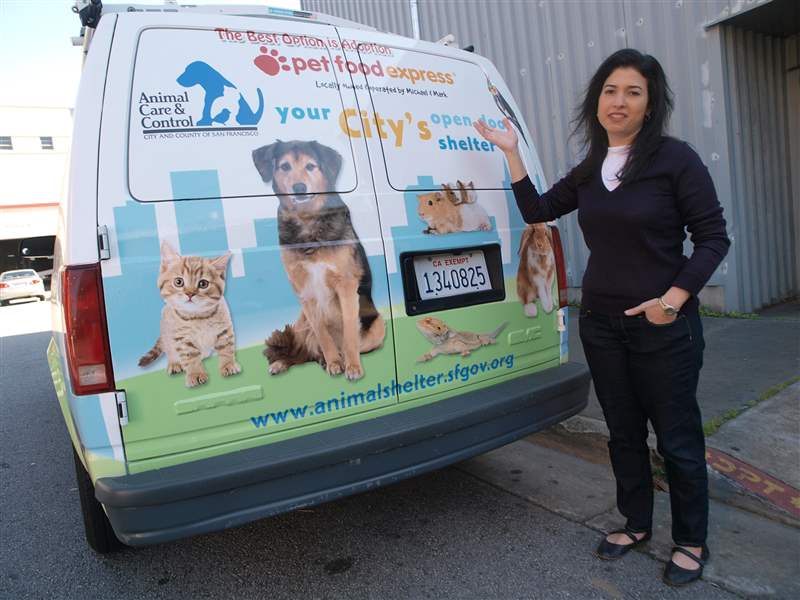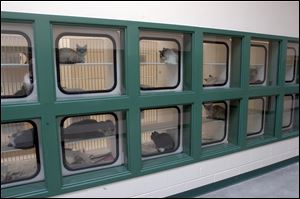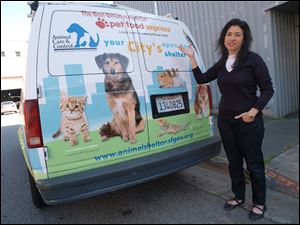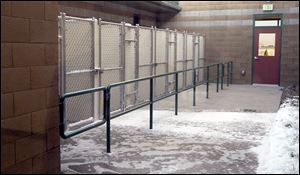
Collaboration results in reduced dog euthanasia rates, officials say
Low-kill areas join forces with community, nonprofits
8/6/2011
Rebecca Katz, director of San Francisco Animal Care and Control, said the agency posts photographs of dogs to be claimed on its Web site but requires proof of ownership.
San Francisco Examiner/Mike Koozmin

Cats fill cages at the Washoe County Regional County Animal Control Center. Animal control shares a facility with Humane Society of Nevada, which handles all adoptions and owner surrenders. County staff focuses on returning dogs to owners.
If you want to know just how closely Washoe County, Nevada, works with private organizations to save the lives of homeless dogs, you need only to stand in the parking lot of its animal-services department and watch the confused faces of those seeking to retrieve or adopt lost pets.
“When people pull into the parking lot, a lot of times they’re not sure where to go,” says Bonney Brown, executive director of the Humane Society of Nevada in Reno.
That’s because the county’s animal-services department and the humane society literally share a building — a brick-and-mortar symbol of the kind of public-private collaboration that officials there and elsewhere said has been key to drastically reducing the number of dogs killed at public animal shelters.
The Blade spoke with shelter officials from half a dozen counties where euthanasia rates have been cut to about 10 percent, far less than Lucas County’s 48 percent. Those counties vary in size, location, demographics, and funding, but when it comes to saving dogs’ lives, they share some potentially instructive characteristics.
Most of the shelters reduced their rates in just one or two years, usually after a change in shelter leadership, suggesting that commitment is just as important as strategy, manpower, or finances.
“It starts as an act of will,” said Nathan Winograd, former director of the public shelter in Tompkins County, New York, and now executive director of the national No Kill Advocacy Center.
Tompkins County was the first in the country to get its kill rate below 10 percent. Other public shelters that have done the same “share very little demographically,” Mr. Winograd said, “but they share leadership committed to saving lives.”

Rebecca Katz, director of San Francisco Animal Care and Control, said the agency posts photographs of dogs to be claimed on its Web site but requires proof of ownership.
Technology has been one key factor, said Mitch Schneider, manager of Washoe County Regional Animal Services. Residents can purchase dog tags online (in Lucas County, they can only renew licenses online) and animal-control officers can take pictures of dogs in the field and post them to the Web immediately, allowing owners to quickly locate lost dogs. Staff also have computers in their vehicles, so they can run dog tag or microchip information and check lost dog reports. If those efforts fail, they ask residents in the area if they know the dog’s owner.
These factors have greatly reduced the number of dogs arriving at the shelter. Last year, 1,126 dogs were returned in the field and another 2,605 were redeemed at the shelter. That means 49 percent of the shelter’s dogs were returned to owners, compared to 16 percent here.
The dogs that remain are likely to end up with Nevada Humane Society, whose shelter is across the hall. Ms. Brown took over as director in 2007 and increased pet adoptions 50 percent in the first year. Last year, the shelter accepted about 1,700 dogs a year from the county, many more than the 595 dogs the Toledo Area Humane Society accepted from Lucas County.
Ms. Brown said she accomplished the high adoption rate by lowering fees, holding events to bring the community into the shelter, and taking the pets out into the community. While the Toledo Area Humane Society also holds events frequently, it generally charges $50 to $150 more for a dog than the Nevada society.
Because of the success, Ms. Brown said there has seen a surge in volunteers. About 900 volunteers shelter pets until they are old enough to be spayed or neutered. The Toledo humane society has 81 such volunteers.
Lucas County and Humane Society officials here said they have a good working relationship and don’t see many ways they could better cooperate. “We have very different but complementary positions,” said John Dinon, executive director of the Toledo Humane Society.
As for better utilizing technology, Lucas County Dog Warden Julie Lyle said although her office puts up photographs of adoptable dogs on the Web, she has concerns about putting up photographs of dogs that fall within the three to 14-day window for owner redemption. “There can be false claims on dogs,” she said.

Fences prevent people from getting too close to the dogs at the Washoe County Regional Animal Control Center. Last year in Washoe County, 3,731 dogs, or 49 percent, were returned to their owners.
Successful shelters also said publishing their outcomes online has been helpful in garnering public support. That’s something Lucas County plans to do soon, Ms. Lyle said.
While part of Washoe County’s success stems from its larger animal services budget — $4.2 million a year compared to Lucas County’s $2.1 million — other communities maintain low kill rates on much smaller budgets.
In Shelby County, Kentucky, for example, animal services gets $143,600 a year, which doesn’t cover much more than the salaries of its three employees. Still, it killed only 5 percent of its 900 dogs last year.
Bradley King, animal control supervisor, said they use a team of four or five nonviolent offenders from the county jail to help with things like cleaning cages and feeding animals.
Given the county’s small population, they also transport dogs to adopters and animal rescue groups nationwide through a volunteer network of drivers.
Another big factor for some municipalities in reducing their euthanasia rates has been an emphasis on spaying and neutering pets.

The new law, along with what Mr. Vreeland called “a changing of the guard” at the county shelter, opened the door for greater cooperation with the society and helped reduce the kill rate at the public shelter from 70 percent in 2008 to 1 percent in 2010.
The situation here has improved since Ms. Lyle took over as dog warden in 2010. She killed nearly 1,000 fewer dogs last year than her predecessor did in 2008. And the humane society has stepped up to the plate too, accepting 254 additional transfers last year.
But Ms. Lyle said the economy has made additional improvements difficult. People are abandoning and surrendering pets at higher rates.
“You have to put priority on feeding your family,” she said.
Contact Tony Cook at: tcook@theblade.com, or 419-724-6055.